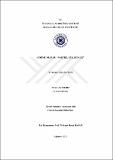Please use this identifier to cite or link to this item:
http://hdl.handle.net/11547/2257Full metadata record
| DC Field | Value | Language |
|---|---|---|
| dc.contributor.author | Ayyıldız, Ayşe | - |
| dc.date.accessioned | 2019-05-28T07:01:04Z | - |
| dc.date.available | 2019-05-28T07:01:04Z | - |
| dc.date.issued | 2017 | - |
| dc.identifier.uri | http://hdl.handle.net/11547/2257 | - |
| dc.description.abstract | Bu çalışmada, insanın var olma kaygısı sonucu kendini resmetmeye başlamasıyla ortaya çıkan portre resminin zaman içerisinde “ben” imgesi haline gelmesi incelenmiştir. Birinci bölümde, portrenin varlığını ortaya koyacak olan görme olgusunu ve görmeyi oluşturan göz ele alınmış, görmenin seyretmeye dönüşmesi ve insanın kendini nasıl kendi arzu nesnesi haline getirdiği incelenmiştir. İkinci bölümde, portrenin “ben” imgesine dönüşmesi mitolojik açıdan araştırılmış olup “Yüz Nedir?” sorusuyla tanımlanmış ve insanın kendi yüzünü görebilmesi için gerekli olan ayna olgusu incelenmiştir. Ardından portrenin kimlik oluşturma süreci ve portrelerin maske olarak kullanımı araştırılmıştır. Son bölümde ise portrenin din, felsefe, mitoloji, fotoğraf, resim, sosyal medya ve sinema sanatlarından güç alarak zaman içerisindeki oluşumu ve tarihsel süreci incelenmiştir. | tr_TR |
| dc.language.iso | tr | tr_TR |
| dc.publisher | İSTANBUL AYDIN ÜNİVERSİTESİ SOSYAL BİLİMLER ENSTİTÜSÜ | tr_TR |
| dc.subject | Portre | tr_TR |
| dc.subject | Ayna | tr_TR |
| dc.subject | Yüz | tr_TR |
| dc.subject | Narsisizm | tr_TR |
| dc.subject | Ben | tr_TR |
| dc.subject | Portrait | tr_TR |
| dc.subject | Mirror | tr_TR |
| dc.subject | Face | tr_TR |
| dc.subject | Narcissism | tr_TR |
| dc.subject | Me | tr_TR |
| dc.title | GÖRME OLGUSU “PORTRE, YÜZ, BENLİK” | tr_TR |
| dc.type | Thesis | tr_TR |
| dc.description.abstractol | In this paper the portrait that emerged as the man started painting it out of his worries of existence and how that portrait turned into an image of “himself” in time are stuied.In the eye that generates seeing and the phenomenon of vision is approached, watching and how the man made himself into an object of desire is studied. In the second chapter, the transformation of the portrait into an image of “me” is researched form a mythological aspect and is defined by the question “What is face?” and the phenomenon of mirror which is required form an to see himself is stuided. After that, portrait’s process of forming an identity and the usage of portraits as masks are examined. In the last chapter, the formation of portrait in time, empowered by religion, philosophy,mythology, photography,painting,social media and cinema arts and the portrait’s historical process are approached. | tr_TR |
| dc.publisher.firstpagenumber | 1 | tr_TR |
| dc.publisher.lastpagenumber | 58 | tr_TR |
| Appears in Collections: | Tezler -- Thesis | |
Files in This Item:
| File | Description | Size | Format | |
|---|---|---|---|---|
| 481930.pdf | 2.8 MB | Adobe PDF |  View/Open |
Items in DSpace are protected by copyright, with all rights reserved, unless otherwise indicated.
